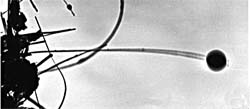Challenge of the balance
 the first equal-arm balance was used by the ancient Egyptians some 5,000 years ago. The ancient Romans further improved the balance. In the 18th century came the use of edges of knives. In more recent times, accurate electrical balances replaced the balance in most laboratories. But now, researchers at the Georgia Institute of Technology, usa , have demonstrated a nanobalance which is, in principle, capable of weighing viruses ( Science , Vol 283, No 5407).
the first equal-arm balance was used by the ancient Egyptians some 5,000 years ago. The ancient Romans further improved the balance. In the 18th century came the use of edges of knives. In more recent times, accurate electrical balances replaced the balance in most laboratories. But now, researchers at the Georgia Institute of Technology, usa , have demonstrated a nanobalance which is, in principle, capable of weighing viruses ( Science , Vol 283, No 5407).
Walt de Heer and his colleagues used carbon nanotubes to make the balance. First discovered in 1991, nanotubes are sheets of carbon atoms arranged in a hexagonal arrangement and rolled up into tubes with diameters of about one nanometre (one-billionth of a metre). Theoretical studies have indicated that the properties of these tubes make them very sensitive to small changes in their dimensions and orientation. Their unique properties make them desirable for a host of applications. For instance, nanotubes are ideal material for carbon-fibre reinforced materials of high strength and low weight.
The scientists used an electron microscope to view the nanotubes coming out of a carbon fibre. The fibre, in turn, was attached to a gold wire mounted on an insulator. This set-up allowed the researchers to send an electrical current through the nanotubes. The apparatus was put on a special sample holder and placed only 5-20 microns (a micron is one-millionth of a metre) away from an oppositely charged electrode.
Applying an oscillating electrical voltage to the wire caused the tubes to vibrate. The vibration was at its maximum at the resonant frequency, which depends on the mass and other properties of the tube. Attaching a particle to such a nanotube would change this resonance frequency, enabling researchers to deduce the mass of the particle.
With this technique, the researchers measured a graphite particle to be 22 femtogrammes (a femtogramme is one-millionth-billionth of a gramme). The technique can easily be used to measure masses in the range of a femtogramme to a picogramme (one-thousandth-billionth of a gramme). This includes microorganisms and viruses. Once the technique is perfected, it could prove to be a boon for researchers in microbiology and the pharmaceutical industry.
Related Content
- Transformative change and SDG 8: the critical role of collective capabilities and societal learning
- Transition risk management for land-based climate measures
- Addressing ecological connectivity in the development of roads, railways and canals
- Order of the National Green Tribunal regarding protection of desert ecology, Jaisalmer, Rajasthan, 03/02/2023
- A “shared earth” approach to put biodiversity at the heart of the sustainable development in Africa
- Open government and climate change: leveraging transparency, participation, and accountability for effective climate action
